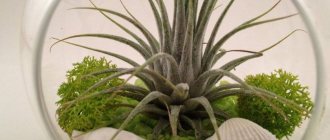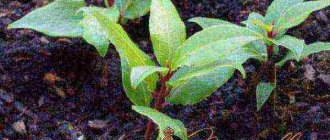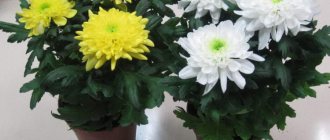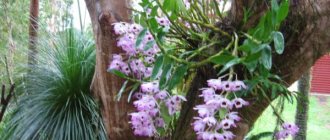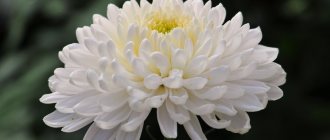Chrysanthemum (Chrysanthemum) is one of the most popular and beloved flowers by gardeners. It looks beautiful in autumn bouquets, blooms for a long time, and has bright inflorescences of various colors. You can find the plant both at your summer cottage and in home flowerpots, where it can decorate the interior of any room. After all, along with some other flowers (rose, gerbera, primrose), chrysanthemum can be grown not only as a garden plant, but also in a pot at home.
History of the plant
Chrysanthemums belong to herbaceous annual and perennial plants of the Asteraceae (Asteraceae) family, which has 29 species. Their representatives have been growing in areas with temperate and cool climates for a thousand years, mainly in Asia (China). In Europe, chrysanthemums began to be cultivated as garden and indoor flowers in the 17th century.
The chrysanthemum is a symbol of the imperial family in Japan, the highest order is named after it. Only the imperial family had the right to wear clothes with a chrysanthemum embroidered on it. The Japanese also call the ninth month after her.
In China, the flower is classified as a medicinal plant. Medicines are prepared from it to treat the gastrointestinal tract, eye diseases, migraines and nervous disorders.
How to replant a chrysanthemum
Young bushes are replanted annually, adults once every 2-3 years, usually in March. Select a pot with drainage holes that is 2 cm wider and 1.5 liters deeper than the previous one. Ceramic or clay would be better.
For soil, mix garden soil, humus, peat, coarse sand 3:1:1:1. Disinfect the soil (with boiling water with manganese or in the oven). You can buy ready-made ones at a flowering store. Expanded clay or vermiculite is placed at the bottom, or broken brick can be used. The whole bush is replanted by transshipment or divided into small ones.
Appearance and useful properties
Large and medium-sized chrysanthemum flowers are double and daisy-shaped and are painted in such bright, rich colors of the most beautiful shades of white, pink, yellow, lilac and purple that you can look at them endlessly. There are two-color specimens, which are also difficult to take your eyes off.
The flower has the property of releasing beneficial phytoncides, which purify the surrounding air from gases and harmful impurities emitted by appliances and finishing building materials operating in the apartment. It is useful to inhale the aroma of chrysanthemum - its smell heals nerves and calms a person.
How to stimulate chrysanthemum flowering
It is important to follow several rules so that the plant blooms faster:
- Water abundantly, not allowing the soil to dry out.
- Make 12 hours of daylight.
- During the formation of buds, the plant should stand in a cool place + 13 ... + 16 ° C.
- While the buds are small, remove the small ones, leaving only the large ones.
- When all the buds open, provide good lighting.
- Transplant into a spacious container.
- Fertilize with nitrogen before flowering.
Which type to choose in the store
For home care, purchase only a potted variety of chrysanthemum, which is fully adapted for home growing. Be careful when choosing a variety. Indeed, in nurseries and greenhouses where chrysanthemums are grown for sale, their growth is artificially inhibited with special preparations (however, without compromising their decorative properties) so that the bush looks neat and compact. If you accidentally buy a garden specimen, you will be very surprised when your little one turns into a huge bush.
For home cultivation, you need to choose one of four types of bush: Chinese, Indian, Korean or Shrub.
Chinese
Chrysanthemum "Chinese" is a low-growing perennial plant with a height of 30 to 130 cm. It has strong, erect shoots with fleshy oval or lanceolate leaves up to 7 cm long. It has large double inflorescences-baskets with a bright aroma.
Indian
Chrysanthemum "Indian" is ideal for growing in pots. The most popular varieties of this species: “Aurora”, “Altgold”, “Snow Elf”, “Ellen” and others.
Korean
Chrysanthemum “Korean” blooms with bright inflorescences in the form of balls. Popular varieties of Korean chrysanthemums: “Navare”, “Orange Jam”, “Stella”.
Shrub
Chrysanthemum "Bush" is an evergreen shrub that reaches a height of one meter. It was brought from the Canary Islands. The shoots are erect and the leaves are divided. The stipules have irregularly shaped lobes. The inflorescences look like simple large baskets with a diameter of 5 cm. Grows well in indoor conditions.
Common indoor chrysanthemums are low-growing and dwarf varieties. This is a bush, the height of which ranges from 15 to 100 cm. The root system of the plant develops superficially. It is highly branched. Light green leaves, dissected, notched or jagged in shape, arranged alternately. Small-flowered chrysanthemum of Indian origin blooms profusely with small flowers up to 2.5 cm in diameter, collected in a rosette and creating beautiful dense inflorescences. The Chinese (mulberry-leaved) variety has large flowers, up to 5 cm in diameter. After flowering, fruits with seeds ripen. The shape of flowers in different varieties of chrysanthemum is also different - double or simple.
After you select the type you like, carefully examine the plant. There should be no stains, mechanical damage and, especially, traces of the vital activity of any insect pests on the leaves, flowers and shoots. Only a healthy, strong-looking plant with lush greenery and bright flowers can be purchased for growing indoors. At home, it is also advisable to place the new pet separately from the other flowers - let it stay in quarantine for a week. This is easier to arrange than later treating the entire flower garden for some infection or removing any parasites that could easily hide in the lush foliage of the purchased flower. If everything is in order, place the new guest among other flowers.
Features of home chrysanthemum
Homemade chrysanthemum is a compact and not very tall bush. The fact is that during its cultivation, special drugs are used to artificially stop growth. However, there have been cases when garden-sized bushes grew from purchased cuttings of home chrysanthemums.
As a rule, low-growing varieties of Chinese or mulberry chrysanthemum are grown indoors. The height of lushly flowering bushes can vary from 0.15 to 0.7 m. Their flowers can be both large, reaching a diameter of about 50 mm, and small (no more than 25 mm in diameter). And varieties may also differ in the shape of the flowers. Flower growers also cultivate some varieties of Indian and Korean chrysanthemum at home.
Flowering of chrysanthemums grown indoors is usually observed in the autumn-winter period. In order for the bush to bloom for as long as possible, it needs to be properly cared for, and it will also need special conditions for growth.
How to care for a chrysanthemum in a pot
The most popular varieties
Breeders have developed many varieties of indoor chrysanthemums. All of them can be divided into four groups:
- Herbaceous varieties - up to 35 cm high, have large dark green leaves with double or simple flowers with a diameter of about 5 cm;
- Varieties of spherical chrysanthemum - from 30 to 60 cm in height. They have many small leaves and flowers, no more than 2.5 cm in diameter;
- Shrub-shaped varieties - up to 50 cm in height, carved leaves, large simple flowers up to 7 cm in diameter;
- Varieties of cascading chrysanthemums have hanging shoots strewn with daisy-like flowers, the diameter of the flowers is 4 cm.
Malchish-Kibalchish
Evening lights First snow
Dune
Zorka
Chrysanthemum “Malchish-Kibalchish” grows no higher than 50 cm in height. The bush is spreading - it grows up to 60 cm in width. It blooms profusely with flowers of rich red, sometimes lilac, color, similar to daisies. The variety is early, unpretentious, blooms profusely, and frost-resistant.
Korean chrysanthemum “Evening lights” is a compact bush, about 35 cm in height. It blooms with large, up to 5.5 cm in diameter, simple red flowers with a yellow center.
Chrysanthemum “First Snow”. The height of the bush can be up to 35 cm, and its width is up to half a meter. The bush is voluminous, but strong and does not fall apart. It blooms with large, up to 5 cm in diameter, semi-double flowers of bright white color from the second half of August for 30 - 40 days.
The Dune variety reaches 50 cm in height and is the same in width. A very early variety. The flowers are large, up to 7 cm in diameter, yellow-brown in color. Interestingly, as the flower opens, its color changes from reddish-yellow-brown to pure golden yellow.
This may be interesting: Cyclamen (Alpine violet) - home care
Chrysanthemum “Zorka” is a bush up to half a meter high, double inflorescences, up to 6 cm, yellow-brown with a copper tint. A very beautiful early variety.
Mascot
Cheburashka
Varvara
Flamingo
Pink-cream
“Talisman” is a low bush, up to 25 cm in height, with small dark crimson inflorescences.
Chrysanthemum “Cheburashka” is a compact hemispherical bush, up to 40 cm high. It blooms with lilac double inflorescences, up to 4 cm in diameter.
In “Varvara” the bush grows up to 40 cm. It is distinguished by such abundant flowering that, due to the double, pink-lilac inflorescences with a yellow center, sometimes flower leaves are not visible.
Chrysanthemum "Flamingo" has a height of up to 50 cm. The flowers are large, up to 7.5 cm in diameter. The color of the petals is soft pink, becoming more saturated towards the center of the flower.
Variety “Pink-cream” - reaches a height of half a meter, blooms for a long time, dense double pinkish-lilac inflorescences have a diameter of up to 8 cm. As they fade, the inflorescences become pinkish-cream in color.
Leaf fall
Raspberry pompom
Okishor
Syaivo
apple blossom
Chrysanthemum "Leaf Fall" - This is a chameleon plant. Its height is up to 45 cm. Its inflorescences are large, reaching a diameter of 7 cm. They are painted pink-red, which changes over time to flesh-yellow.
“Crimson” pompom is a dwarf variety. Its height is up to 30 cm. The inflorescences are hemispherical, with a diameter of 6 cm, pink-crimson in color.
"Okishore" is a powerful bush up to half a meter high. Blooms profusely with pinkish-lilac large inflorescences, up to 8 cm in diameter.
“Syaivo” is a variety of Ukrainian selection. It has large, bright, egg-yellow inflorescences, up to 8 cm in diameter.
Chrysanthemum “Apple Blossom” is a powerful bush up to 50 cm high, with thick stems strewn with large, up to 8 cm in diameter, pinkish-white double inflorescences. Suitable for cutting and forming bouquets.
Peculiarities
For this plant, it is advisable to organize a cold winter from the end of flowering to the beginning of March. Keeping at low temperatures promotes good growth in spring and abundant flowering in autumn.
After flowering, cut off dry shoots and flower stalks . Then the bush is taken out to the cold veranda.
In the spring, when the shoots begin to grow, the plant is again moved into the house.
It is useful to take chrysanthemums out into the garden for the summer . Sometimes they are even planted in open ground, and in late autumn they are dug up, transplanted into pots and taken into the house.
You need to feed the flower only during the flowering period. To do this, use liquid complex fertilizers for flowering plants.
During the period of growth and wintering, the chrysanthemum is not fed.
A chrysanthemum may not bloom if there is no feeding, then the flower will lose its decorative effect.
As soon as the plant begins to grow buds, it is necessary to begin feeding . This procedure is carried out every 2 weeks until flowering ends. The best results are obtained by using special liquid fertilizers for chrysanthemums. But you can use any other compositions to stimulate flowering.
Fertilizers are applied to moist soil. After the next watering, at least 12 hours must pass so that the soil is well saturated with moisture. After this, the fertilizer is diluted with water in the proportion indicated on the package and the flower is watered.
Care at home.
Temperature
Chrysanthemum will grow and bloom at normal room temperature. But not for long. The maximum temperature for keeping chrysanthemums should be no higher than 23 °C in summer, 18 °C in spring and autumn, and even lower in winter.
In order for the flowering of the bush to be long-lasting and colorful, its temperature should be within 15 – 17 °C. The flower is very difficult to tolerate ordinary room temperature, especially the summer heat of 25 - 30 °C. You will see this by its drooping leaves and wilted flowers. This happens especially often with newly purchased copies. If this does happen, urgently move the plant to a cool place (on the balcony, in the entrance) and moisten the soil. The bushes you grow from chrysanthemum cuttings will be more resistant to elevated room temperatures next year.
Flower location
The chrysanthemum pot should be placed in the coolest room, ventilated with fresh air. Plants do not like direct sunlight shining on them. Try to find a place for it on the windowsills of the north-eastern or north-western side of the apartment. At northern windows, the plant will not have enough sunlight, it will stretch out, the shoots will begin to become bare, flowering will be rare or it will not bloom at all. Indoor chrysanthemums feel best on cool but well-lit balconies, verandas and loggias, and with the onset of real warmth it is advisable to take them outside. And so, if you have a suitable cool, well-lit place in the house, this is just what you need.
If you have a summer cottage or garden plot, we recommend planting your chrysanthemum in May - June in open ground so that it grows well there and blooms profusely in the fall. After flowering for the winter, it will need to be replanted in a pot and winterized. Leaving a flower on the site is dangerous due to the unpredictability of winter temperatures.
Lighting
Indoor chrysanthemum is a light-loving flower with short daylight hours, within eight hours. The location of the flower should be well lit, but not by direct, but by diffused sunlight. The morning and evening sun can caress the leaves of the plant, but at noon the bush must be shaded from the sun using blinds or curtains. You can put the flower in the back of the room for this time.
Watering and humidity
Chrysanthemum drinks water well - regular and abundant watering is required. But the soil must be well aerated, that is, it must be constantly moist, but not wet, so that the roots can breathe. If there is insufficient watering, the stems will wither, and if there is excess watering, they will rot and be affected by fungi. During the period of active growth, we recommend watering the plant a couple or three times a week with settled water at room temperature. In the hot season, chrysanthemums are often sprayed; it is better to do this early in the morning or in the evening. Ambient air humidity should be between 65 – 80%. If the air is still too hot and dry, resort to artificial air humidifiers. Sometimes, bathe the plant under a warm shower - the leaves should not be covered with house or street dust.
Soil and pot
For chrysanthemums, store-bought soil for decorative flowering plants is suitable. It should be nutritious, loose and not sour. Self-prepared soil should contain leaf and turf soil, humus and sand. Add some superphosphate or other fertilizer for flowering plants. Disinfect the soil (calcine or steam).
You will need a pot that is not deep, but wide, since the roots grow superficially. Place a fairly thick layer of drainage at the bottom of the planting container - excess moisture is detrimental to the chrysanthemum root system. Expanded clay, clean small stones, and pebbles are suitable for drainage. Be sure to drain the water from the pan.
Transfer
Replant young chrysanthemum specimens annually in slightly larger pots. Use the same soil mixture as when planting. Drainage and drainage holes at the bottom of the pot are a must! Adult plants are replanted every two years. Usually, the transshipment method is used. Carefully remove the flower along with the root system from the old pot and place it in a new, larger pot. Fill all voids and upper layers of roots with new nutrient soil. Water the plant. Give him some time to get used to the new conditions in a shaded place. Afterwards, return the pot to its original place.
Feeding and fertilizer
Chrysanthemums require regular feeding for full growth and abundant flowering. Ready-made fertilizers are suitable for flowering indoor plants. You can use any multicomponent additives in which the content of nitrogen, phosphorus and potassium is in the ratio 1:3:2. They are used during the growing season and flowering of chrysanthemums. From November the plant is not fertilized - the abundant flowering ends and it begins to prepare for winter rest.
This may be interesting: Oxalis (Oxalis) - types and varieties
Trimming
Chrysanthemums are pruned twice a year. This is done in spring and summer in order to form a beautiful crown of the bush. The first pruning is done in the spring after planting or replanting a flower. The growing point at the top of the shoots is removed from the plant. The side shoots immediately begin to grow actively. Before our eyes, the chrysanthemum turns into a lush, dense bush. About a month later, this procedure is repeated. If you grow a spherical variety of chrysanthemums, then it is not necessary to pinch it. A lush, dome-shaped bush is a varietal feature of these types of chrysanthemum.
The chrysanthemum is pruned again in the fall, after flowering. First of all, dry, diseased and rotten shoots are cut off to keep the rest of the bush healthy. The remaining shoots are also shortened, since the plant will overwinter in spartan conditions - without watering, fertilizing and light. This will make it easier for him to survive during hibernation.
The chrysanthemum in the pot has faded, what to do next?
When the flowering time ends and the dormant period begins. This is an extremely important time of the year for the plant, when it rests and gains strength before the new active season and the question of what to do next with the chrysanthemum in the pot becomes relevant.
To extend the flowering period, it is necessary to remove dried leaves and flower buds from time to time. On hot days, the flower is placed in a cool place.
After the chrysanthemum in the pot has bloomed, all its shoots must be cut off, leaving “stumps” no more than 15 cm high. For the winter, the plant needs to be put in a cool but well-lit place and watered regularly, but very sparingly: only enough so that the bush has enough strength to “survive” until spring.
A home flower can overwinter on the same windowsill where its growing season took place. In this case, care for it is carried out according to the same rules as before. And to prevent the shoots of a faded potted chrysanthemum from stretching out, it may need additional lighting.
Bloom
Chrysanthemums bloom at home for a long time, more than a month. Flowering occurs in the autumn months. For more luxuriant flowering, during the growing season, up to mid-August, it is necessary to pinch the shoots two to three times. In order for the plant to develop more actively and form a larger number of buds, use biological products that stimulate its growth, such as Bud, Epin, Zircon. It is believed that the use of a light solution of potassium humate promotes rapid plant growth, expansion of its root system and an increase in the number and size of buds.
In the future, during flowering, regularly trim dried stems and faded buds so as not to create conditions for pests and not to spoil the decorative appearance of the bush.
What to do if the chrysanthemum has faded?
Under natural conditions, after the chrysanthemums fade, winter comes. The bushes go into hibernation. You need to create something similar at home.
After your chrysanthemum has bloomed, cut all its shoots to a height of 10 - 15 cm; weak and diseased shoots - cut to the root. Water and store in a cool, dark place until spring. Its temperature in winter should be between zero and three degrees. Such temperatures are maintained in winter in cellars and basements. There you will keep the flower until spring. In early spring, when new shoots begin to grow, the plant is brought indoors, replanted in new soil and placed on a well-lit windowsill.
If you do not have a basement or suitable cellar, the chrysanthemum will have to be kept in some other suitable place in the winter. An insulated balcony, a glazed veranda or a window sill in the entrance, where the temperature will not exceed 8 degrees, is suitable. Watering is almost not required; once during the entire wintering period will be enough.
If there is no cool room in the house, your chrysanthemum will have to spend the winter on the windowsill in the apartment, closer to the cold glass. You also trim it a little, remove all dry leaves, shoots, buds. Replant in new nutrient soil. Care for the flower as before - water moderately, do not let the root system dry out, but do not overwater it. Make sure that the bush is well lit from all sides - turn it with different sides to the sun. Ventilate the room. In a month and a half, your beauty will grow again. Shape the crown - trim shoots that are too elongated, pinch them. Then the bush will become more magnificent and form more buds. Feed him. Keep in mind that since you have deprived the chrysanthemum of a full winter rest, the flowering will not be as lush and long-lasting as the first time. After the next flowering, you will have to part with the flower or, nevertheless, organize a full rest break for it (place it in a cold place for the winter until spring).
Why didn't the chrysanthemum bloom?
Everyone is waiting for the obligatory abundant flowering of the chrysanthemum bush in early autumn and even earlier. If flowering does not occur at the appointed time, it means that you did something wrong during the many months of caring for the flower. Reasons that could cause the lack of flowering:
- insufficient lighting,
- poor soil composition,
- lack of fertilizers or excess nitrogen component in them,
- late pruning of a bush, in which you cut off shoots with buds.
Analyze your actions and correct mistakes. If the bush is generally strong and healthy, it will definitely delight you with its magnificent flowering next year.
Watering
Before watering a chrysanthemum in a pot, you need to check the condition of the soil. For normal plant development, the soil must be constantly moist, but it should not be over-moistened.
And drying out a clod of earth is detrimental to the plant; if the soil in the pot dries out completely, the plant will die.
The optimal humidity of the earthen ball is maintained all year round, both during growth and flowering, and during wintering.
Water the plant with settled tap water at room temperature.
Chrysanthemums grow well with moderate air humidity in a city apartment. There is no need to specifically increase or decrease it.
Spraying is not a mandatory procedure for caring for the plant, but it does not harm it. In summer, you can spray the plant 2-3 times a month to remove dust from the leaves.
During the flowering period, spraying is stopped so that water does not get on the flowers and cause them to rot.
Reproduction
Chrysanthemums are propagated using cuttings, dividing the bush and seeds. The simplest and most successful are the first two. Let's look at them in order.
Cutting method
Select a healthy, strong cutting with three to four internodes with leaves. Remove the lower leaves. There are two ways to root cuttings: in water and in soil.
To root a chrysanthemum cutting in water, place it in a glass of warm, settled water in which part of an activated carbon tablet is dissolved. Place the glass in a well-lit place (but not in the sun). Add water from time to time. The roots will appear soon. When they become 2 cm in size, the cuttings can be transplanted into a small pot with suitable loose soil (most importantly, not acidic). Cover with film or a bag to create a greenhouse effect. It is necessary to water a little at a time so that the roots do not rot.
To root in the ground, treat the tip of the prepared chrysanthemum cutting with root or heteroauxin to stimulate the appearance of roots. Place your cuttings in a pot with suitable loose soil to a depth of 1.5 cm. Water a little with warm, settled water with the addition of the same root. Cover the pot with film. Place in a bright, warm (about 20 degrees) place. Ventilate the greenhouse periodically and water it drips as necessary to prevent fungal infections.
Further, the process of rooting cuttings will proceed in the same way using both methods. After some time, when you realize that the cuttings have taken root well, new leaves have appeared and begun to grow, remove the cover. When the cutting grows to 15–20 cm in height, we recommend pinching the growing point to stimulate the formation of side shoots. When the side shoots grow to 10 - 12 cm, you also pinch them at the top for the same purpose. Then your stick-cutting will turn into a lush bush. By autumn, countless buds will be formed on it, which, when blooming, will decorate your room with unusually beautiful inflorescences with a charming aroma of flowers.
Experienced gardeners root several cuttings in one pot at once, in case one of them does not take root and dies. In addition, cuttings from chrysanthemum varieties of different colors planted together look very good during flowering.
Reproduction by dividing the bush
Reproduction by dividing the bush is used during the period of intensive growth of young chrysanthemum shoots. Up to 6 shoots can grow on one bush. Carefully separate the selected shoot with the root system from the mother bush. Place your seedling in a prepared wide but not deep pot with a suitable soil composition, carefully cover the roots with soil, and water well with settled warm water. Carry out the next watering after the top layer of soil has dried thoroughly. Do not overwater the bush so that the roots have time to absorb the received moisture and do not rot. In a month, the bush will have taken root well, and you can begin to shape it. If you do everything correctly, you will admire its wonderful inflorescences in the fall.
This may be interesting: Gloxinia (sinningia) - growing and care at home
A similar method is when the entire adult chrysanthemum bush is taken out of the pot, its roots are carefully shaken off and the bush is divided into several parts so that each part has its own roots. Plant these flower parts in your own pots and grow them as described above.
Propagation by seeds
Propagation of chrysanthemum by seeds is the most difficult method, therefore it is rarely used. It is generally impossible to grow spherical varieties from seeds, since they are obtained artificially. If you plant Multiflora seeds, you will get an ordinary chrysanthemum without a hint of the characteristics of the variety. Korean varieties and hybrids propagate best by seeds.
If you decide to grow your favorite chrysanthemum variety from seeds, we will help you. Only those seeds that you purchased in specialized stores are suitable. You can grow and collect your own seeds, but the likelihood that they are ripe enough to sprout after planting is quite low.
Prepare a container with a lid. Fry the soil, consisting of peat and humus in equal parts, at a temperature of 110 - 130 degrees. You can use ready-made soil for flower plants from the store. Spread the chrysanthemum seeds over the surface, lightly pressing them into the soil. Moisten the substrate with a fine spray bottle. Close the lid. Place the container in a warm place in the shade. Ventilate the plantings from time to time and moisten them. After the seedlings have sprouted and grown a little, they should be placed in a well-lit place and thinned out. From mid-February to early March, it is advisable to transplant grown seedlings with three to four true leaves into separate pots according to all transplanting rules. Then young chrysanthemums will grow on their own. Spray them with a solution of Zircon or Epin to make rooting faster and more successful. Start lowering the temperature and start caring for them like adult plants: water, pinch, feed, protect from heat and insects - that is, do everything so that the grown chrysanthemums thank you for your care with abundant colorful flowering.
Soil and pot for bush chrysanthemums
If the plant was purchased in a store or nursery, then most likely it was already in a pot and with the correct soil. For some time, until it fades, the plant can be left alone. And then the container needs to be replaced with a larger one, and the soil needs to be updated. For chrysanthemums, ceramic or plastic pots are most often used; the main thing is to choose a stable shape and check for a drainage hole.
For chrysanthemums, ready-made soil for flowering plants, which is sold in stores and garden centers, is perfect. Although many gardeners believe that it is better to prepare it yourself, since this is the only way to ensure maximum results. With all the advantages of this method, it has one significant drawback: it is more labor-intensive. For 2 parts of turf soil you need to take 1 part of leaf soil, humus and coarse sand, and then this mixture must also be disinfected. If the mixture is prepared independently, and the soil is taken literally from the garden, then it needs to be calcined in the oven or poured boiling water over it, and then dried to its normal state. Disinfection is also carried out using a solution of potassium permanganate.
Preference for ceramic pots
As for fertilizers, chrysanthemums love not only ready-made compounds, but also home-made organic matter. Some gardeners advise taking chicken manure. Firstly, when growing these flowers on the balcony in an ordinary apartment, you still need to get it somewhere. Secondly, without analysis it is impossible to know how suitable its chemical composition and acidity are. If you overdo it, you can get acidification of the soil, and this is harmful for any plant.
Diseases
Viral diseases:
- Aspermia. This disease leads to deformed flowers and mottling of chrysanthemum leaves.
- Seedless. Chrysanthemum varieties with bronze-red inflorescences are susceptible to this infection. The flowers of a diseased plant acquire a yellowish tint. The reed flowers of diseased chrysanthemums become deformed and become of different lengths.
- Dwarfism. This disease provokes stunted plant growth and early flowering with deformed flowers.
- Ring spot. This viral infection causes yellowish rings to form on the leaves of the plant. Leaves become deformed and decrease in size.
- Mosaic. This viral infection causes mosaic spots to form on the leaves.
There is no cure for viral infections. The diseased plant must be destroyed along with the soil. The pot can be disinfected and only then used. To avoid infecting other flowers with viruses, it is advisable to sterilize all tools used.
Diseases of fungal origin:
- Powdery mildew. This infection mainly destroys young shoots and covers the leaves and flowers of chrysanthemums with a white, powdery coating.
- Rust. This is also a fungal disease. The leaves turn yellow, the shoots become brittle. The plant becomes covered with round brown spots and fungal spores.
- Septoria. The infection affects chrysanthemum leaves. The spots on them appear first yellow, and then dark brown. An untreated plant will die.
- Gray rot. Brown spots will appear throughout the plant, which in turn become covered with a gray coating. The chrysanthemum begins to rot.
We recommend treating fungal infections with chemicals - fungicides. Copper oxychloride and Fundazol treat rust, septoria and gray rot well, and Bordeaux mixture is used against powdery mildew. Modern drugs, such as Fitosporin, cope with all types of fungal infections.
All these diseases are rather dangerous for garden chrysanthemum species, as well as for those indoor ones that you planted in open ground for the summer. The infection enters the flower from the soil or is transmitted by insects - pests from diseased plants. When grown indoors, chrysanthemums rarely suffer from infectious diseases. However, if the basic rules for caring for indoor flowers are violated, non-infectious problems may arise.
Growing problems, diseases and pests
If you follow the rules of agricultural technology, there are usually no problems with chrysanthemums. But due to drafts, hypothermia, excessive watering or infection, brown or black spots may appear on the leaves. This is a symptom of a fungal disease. It will be necessary to urgently improve the care of chrysanthemums by reducing watering, slightly increasing the temperature, improving lighting, and removing wilted parts.
Important! For treatment, treatments are carried out with fungicidal preparations, for example, “Topaz”, “HOM”.
At home, chrysanthemums are threatened by spider mites, aphids, thrips, and when kept on open balconies, by whiteflies. If drying of foliage, suspicious spots on leaves and flowers, or traces of foliage eating are detected, treatment should be carried out with insecticides and acaricides: “Aktara”, “Fitoverm”, “Sunmite”.
The variety of modern hybrid indoor chrysanthemums is very large; you can choose the size, shade and even aroma to suit your taste. Caring for indoor bushes is not difficult, and the results are truly breathtaking!
Pests
Indoor chrysanthemums are more often visited by aphids and thrips, and less often by spider mites. You will guess about the appearance of parasites by the appearance of the flower - the leaves will begin to turn yellow, traces of insects, sticky discharge or white cobwebs will appear on them. The plant urgently needs to be saved. Wash the chrysanthemum under a warm shower in the bathroom - more parasites will be washed away with the water. Then the flower must be treated with some insecticide against insect pests. Aktara, Aktellik, Fitoverm and many other insecticides are sold in stores with instructions. Read them and treat the plant according to the instructions.
Autumn is coming, the days are getting shorter, and it’s getting colder outside. The majority of indoor flowers have already bloomed and are preparing to go dormant. And for the indoor chrysanthemum, the desired flowering time has come. For almost a year they carefully looked after her, maintaining her beauty and health, and now, as if in response, she bloomed with magnificent multi-colored, very bright, inflorescences. Isn't it a tempting picture?! Try growing this wonderful plant on your windowsill. With proper care in spring and summer, you will admire its magnificent blooms all fall.
If you gave a chrysanthemum in a pot - how to care for it, care after purchase
After purchasing a houseplant, it is important to leave it for a short period of time to adapt.
The flowerpot should be placed on a windowsill where there is enough light, but the flower should be protected from direct ultraviolet rays. For 14 days it is completely at rest, watering is carried out if necessary. Don’t worry if the flowers dry out a little or the leaves fall off; this is normal during the adaptation period.
After the specified period, the flower can be replanted; for replanting it is better to use special soil with the addition of peat. Replanting is not carried out if the plant is blooming; in this case, you need to wait until the flowering period ends.
For the procedure, use a flowerpot several centimeters deeper and wider than the previous one.
New soil, even purchased, must be disinfected with boiling water or a solution of potassium permanganate. Use the soil when it dries.
It is important not to forget to do drainage. Then fill it with the nutrient mixture. Transplantation is carried out by transferring from a flowerpot to a new pot.
The day before transshipment, water the plant well. Constantly monitor the condition of the ground. Do not allow the soil to dry out or flood. Watering is carried out approximately twice a week. Settled water is used. If there is excess water in the pan, it must be poured out. If the room is not hot, then it is enough to water the chrysanthemum once every 7 days.
Lighting plays an important role. The flower loves light; if there is not enough light, this will negatively affect the duration of flowering and the number of buds.
Temperature conditions. The ideal temperature is 15 degrees. The temperature in the room where the plant grows should not exceed 18 degrees, otherwise problems will begin with the growth and appearance of the flower.
The last step is feeding. After purchase, there is no need to add fertilizer for a month. In the future, an adult flower needs feeding before the formation of buds and after winter dormancy. Organic matter and minerals are used as fertilizer: potassium and magnesium.
Now it’s worth thinking about pruning and propagating the flower.
How to trim a chrysanthemum
Bush formation
Pruning involves removing the upper part of the stem, due to which the growth of the plant slows down, the root system develops, and side shoots appear:
- Start pruning 10-15 days after planting.
- From a stem 12-15 cm long, cut off the upper part of the plant with 3-4 leaves with a sharp knife or pruning shears.
- After pruning, water the plant with nitrogen fertilizer.
- 2-3 weeks after pruning, shoots form in the leaf axils.
Do not prune during transplantation.
Preparing for the rest period
After flowering, chrysanthemums must be pruned. Step back 5-10 cm from the soil surface and use pruning shears to cut off the stems of the plant.
If you notice that the plant is damaged by aphids, cut off the diseased stems. Healthy plants cannot be pruned after sick ones with the same tool.
After pruning, the plants are removed to a cool (no more than +5°) dark room until spring. Pruning is necessary. The plant will rest and gain strength for better growth and flowering. During rest, the plant should be watered occasionally.
You can postpone the rest period if the bush is healthy and strong enough:
- Trim the plant and transplant it into a larger container. Completely replace the old substrate with a new one.
- Place the chrysanthemum in a bright, warm place, temperature from +18° to +20°.
- Water the flower 2-3 times a week.
- Feed with nitrogenous fertilizer once every 2 weeks.
- After the first buds appear, feed the plant with potassium-phosphorus fertilizer.
With proper care, the chrysanthemum will bloom in 2-2.5 months. But after flowering it must be sent to rest.



